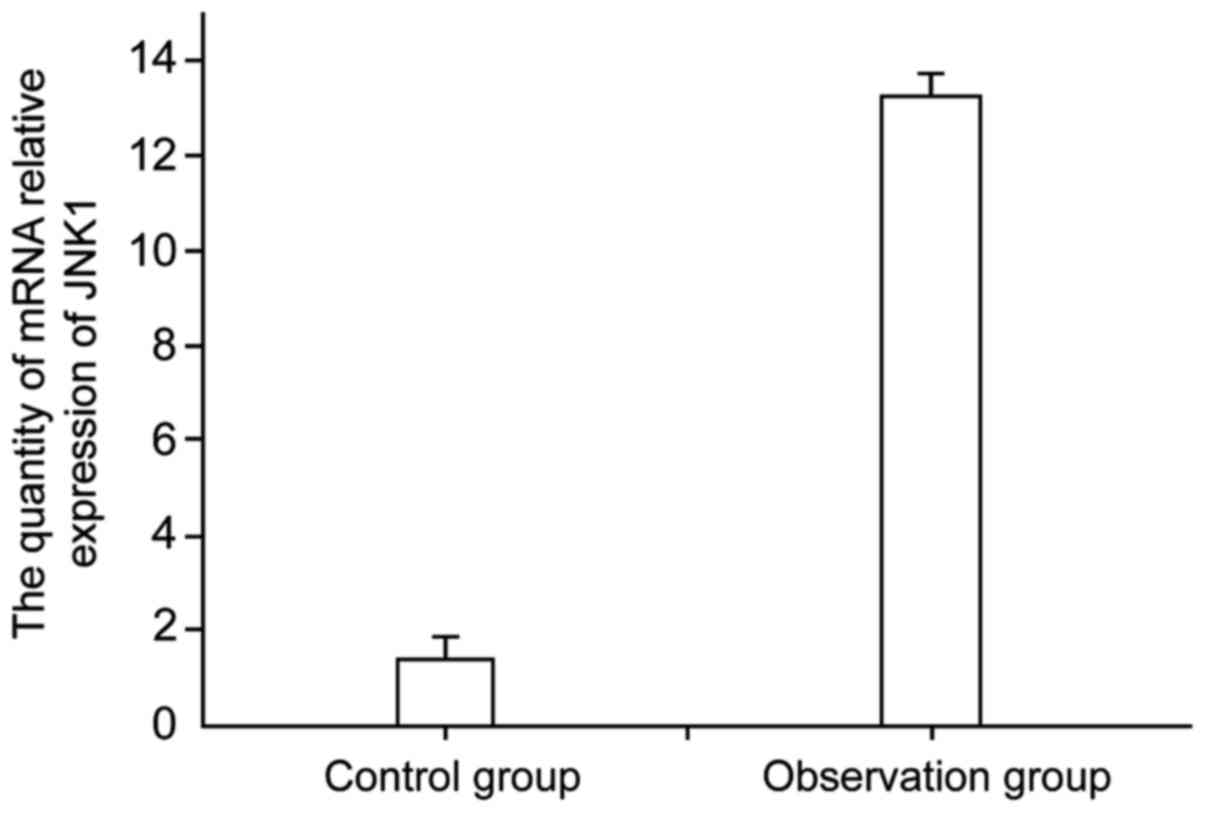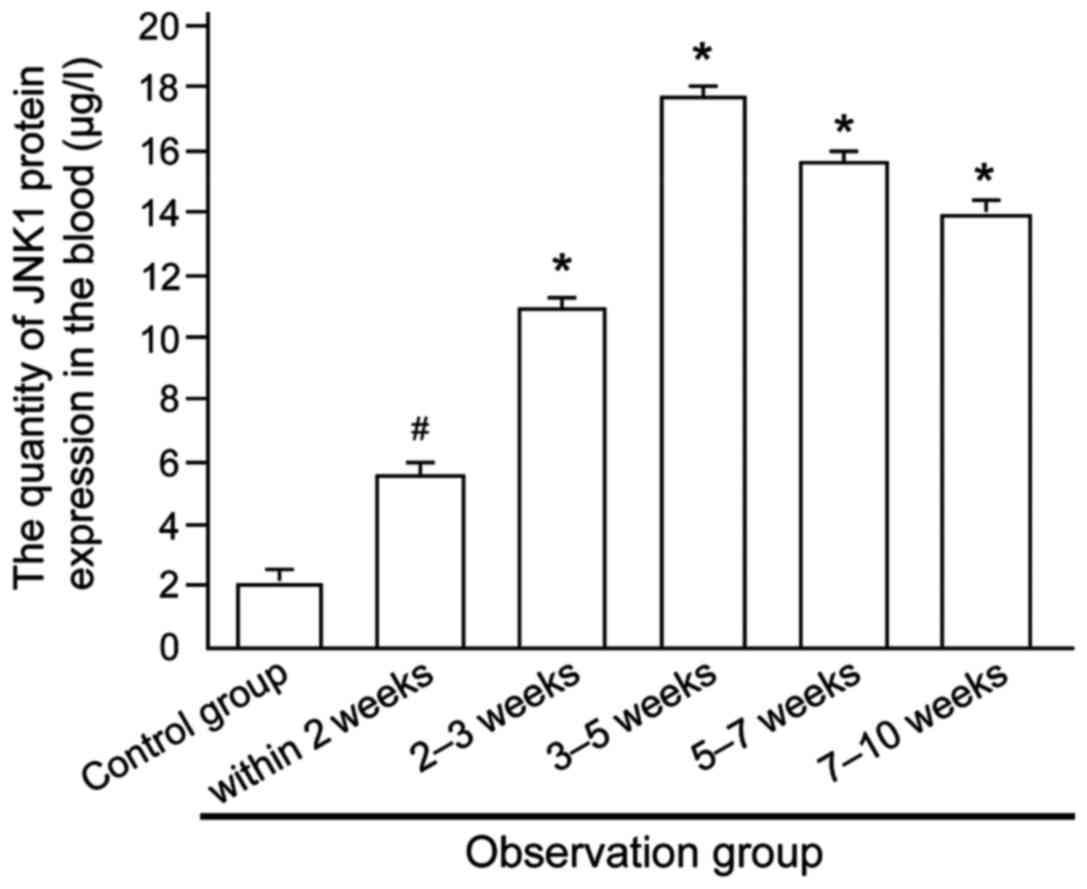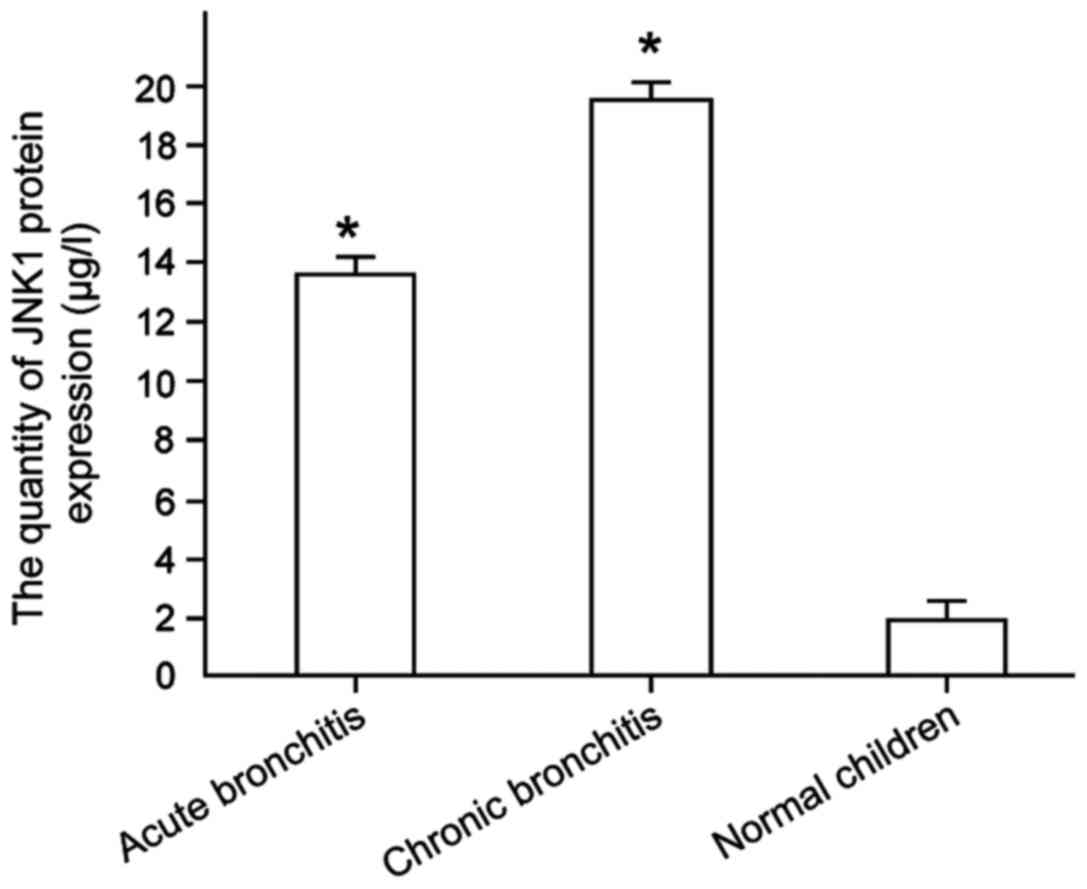Correlation study between gene and respiratory disease in children
- Authors:
- Published online on: June 22, 2017 https://doi.org/10.3892/etm.2017.4643
- Pages: 1463-1466
-
Copyright: © Liu et al. This is an open access article distributed under the terms of Creative Commons Attribution License.
Abstract
Introduction
Infants are very susceptible to infection with external pathogens that can cause a series of diseases, which results from the underdevelopment of teh infantile immune system so that the resistance for the external adverse conditions is weak (1). As a common disease in infants, respiratory disease has high incidence and recurrence (2). Mild pediatric respiratory diseases mainly manifest as acute upper respiratory infection, bronchitis, asthma and pneumonia, while severe respiratory system disease in children may gradually develop to severe pneumonia and even lung failure. Therefore, it is extremely significant to enhance the diagnosis and treatment for respiratory diseases in children (3). As a common respiratory disease in children, bronchitis is mainly caused by pulmonary capillary bronchial lesions by virtue of the common cold or the flu. The study indicated that approximately 80% of children with bronchitis suffered from viral infection caused by respiratory syncytial virus, and adenovirus infection followed (4). At present, the research for pediatric bronchitis has been mainly concentrated on the level of bacteria, viruses, and other exotic microbes, which are rarely reported in the study of related genes (5).
Previous findings have shown that human c-Jun N-terminal kinase (JNK) and stress-activated protein kinase (SAPK) signaling pathways are involved in the production and deterioration of various diseases of the respiratory system (6). In addition, it was previously found that there was a correlation between the phosphorylation of JNK as well as related proteins and diseases such as bronchial asthma (7), suggesting that JNK1 may be one of the important binding sites of anti-airway remodeling. It has been proven that there was a certain correlation between JNK1 gene and asthma in children. However, the correlation of JNK1 and children bronchitis was not reported.
In the present study, we first investigated the mutuality between JNK1 and bronchitis in children, and identified that JNK1 promotes the production and deterioration of bronchitis in children, which provides certain theoretical and experimental basis for the diagnosis and treatment of the pediatric bronchitis.
Materials and methods
General information
Between April 2013 and April 2015, 32 children with an average age of 6.5±3.8 years were admitted to the Xuzhou Children's Hospital (Jiangsu, China) for bronchitis were enrolled in the present study, including 17 males with an average age of 6.2±4.5 years and 15 females with an average age of 6.7±3.2 years. The patients in the observation group were consistent with a previous study (8). Exclusion criteria for the study included other respiratory diseases and inflammation. Twenty-eight healthy children were selected as the control group; average age of 6.3±4.1 years in the same period, including 14 males with an average age of 5.8±3.7 years and 14 females with an average age of 5.4±4.2 years. Venous blood samples (5 ml) were obtained from the subjects in the experimental and control groups, respectively. The cells were collected by centrifugation at 2,750 × g for 5 min. Frozen storage solution was added and the cells were stored in the refrigerator at −80°C.
Approval of the study was provided by the Ethics Committee of Xuzhou Children's Hospital. Written informed consent was obtained from the children's parents or guardians.
Method
The protein extraction kit used in the present study was purchased from Shanghai Biological Engineering Co., Ltd., Shanghai, China; rabbit anti-rat primary antibody used in western blotting was purchased from Abcam Co. (Cambridge, UK); goat anti-rabbit HRP secondary antibody was purchased from Suzhou Keqing (Suzhou, Jiangsu, China); and the RNA extraction kit was purchased from Takara Co. (Dalian, China). Other relevant molecular reagents were purchased from Axygen Biotechnology Co., Ltd. (Silicon Valley, CA, USA).
Quantitative polymerase chain reaction (qPCR)
RNA extractionFrozen samples (0.2 g) were defrosted in the prepared ice box. RNA Plus (0.5 ml) was added, samples were crushed in a precooling mortar, and then immediately moved into a 1.5 ml RNase-free EP tube (Thermo Fisher Scientific, Beijing, China). RNA Plus (0.25 ml) was used to rewash mortar and the washing solution was placed into a centrifugal tube. Then, 200 µl chloroform was added to the centrifugal tube and agitated for 15 sec, prior to placing the tube on the ice for 15 min. This was followed by centrifugation at 10,000 × g, at 4°C for 15 min. The supernatant was transferred into an RNase-free EP tube and an equal amount of isopropanol was added. After quickly reversing and mixing, the tube was placed on ice for at least 10 min prior to centrifugation at 10,500 × g for 10 min at 4°C. The supernatant was discarded, 750 µl 75% alcohol was added and gently mixed, and centrifuged at 10,000 × g for 10 min at 4°C. Again the supernatant was discarded and residual alcohol cleared. RNase-free water was added and the extracted RNA measured. The remaining RNA was used for reverse transcription (9).
qPCRReferring to the Takara fluorescence qPCR specification for operation, with a little improvement, the qPCR primer was synthesized by Shanghai Biological Engineering Technology Co., Ltd. The sequences are shown in Table I.
Enzyme-linked immunosorbent assay (ELISA)The levels of JNK1 protein expression in different samples were detected following the ELISA kit instructions, with slight modifications (10). In the present study, the ELISA standard protein sample was diluted at 1:50 in the assay buffer, and the ELISA standard curve was prepared according to the procedures in the manual. Samples tested were diluted at 1:100 with the phosphate-buffered saline (PBS) (pH 7.2). Then, 100 µl of dilution was added into each well, and 50 µl of detection solution was subsequently added. After 2-h incubation at room temperature, the TMB chromogenic substrate was added. Absorbance was measured at 495 nm, and the D44V6 content and concentration of each tested sample were calculated by interpolation from the standard curve.
Western blottingExtracted total protein (150 mg) was extracted from experimental samples stored at −80°C (11) and ground with a mortar and pestle in liquid nitrogen. Powdered tissue was collected in a 1.5 ml EP tube. Protein extraction solution (300 µl) and 10 µl protease inhibitor were added, incubated in ice water for 30 min and centrifuged at 10,000 × g for 15 min, and then supernatant was collected for analysis. Subsequently, the protein expression levels were detected using western blotting. Approximately 10 µl supernatant was extracted and mixed with sample buffer, followed by SDS-PAGE electrophoresis and routine transmembrane were performed. The samples were sealed at room temperature for 1 h, and incubated with rabbit polyclonal DDR-1 antibody (dilution, 1:250; cat. no. ab135643) and then with secondary goat anti-rabbit (HRP) IgG antibody (dilution, 1:2,000; cat. no. ab6721) (both from Abcam, Cambridge, MA, USA), respectively. After washing the membrane three times, color was developed using diaminobenzidine (DAB). Images were obtained using the Fluorchem 9900 imaging system (Tokyo, Japan). Integral optical density (IOD) values of each chromogenic protein band were measured and the relative protein content of DDR1 was calculated (12).
Statistical analysisSPSS 20.0 software (IBM Corp., Armonk, NY, USA) was used for statistical analysis. The experimental data were presented as means ± standard deviation. One-way analysis of variance (ANOVA) was applied for intra-group comparison. P<0.05 was considered statistically significant.
Results
mRNA expression level of JNK1 in the control and observation groups
Blood samples were obtained from normal children and children with bronchitis, and the mRNA expression level of JNK1 in the different samples was detected by qPCR (Fig. 1). The results show that the JNK1 expression in children with bronchitis was higher than that of the control group, with a significant difference between the two groups (P<0.05). This indicated that there was a certain correlation between the level of mRNA expression of JNK1 and pediatric bronchitis attack, namely, that JNK1 expression levels increased in patients with bronchitis.
Protein expression level of JNK1 in the control and observation group was detected using ELISA
JNK1 protein in the blood of normal children and children with bronchitis was detected using ELISA (Table II). From the results it can be concluded that JNK1 protein expression in the blood of patients with pediatric bronchitis was significantly increased (15.71±0.16 µg/l) compared to that of the normal children with (1.04±0.13 µg/l), showing a significant difference between the two groups, which indicated that the content of JNK1 protein in the blood of patients with pediatric bronchitis was higher than that of normal children. As the result was consistent with qPCR, it showed a certain positive correlation between content of JNK1 protein and pediatric bronchitis.
Table II.Level of JNK1 protein expression in the blood of normal children and children with bronchitis (µg/l). |
Protein expression level of JNK1 in the control and observation groups was detected by western blotting
The level of JNK1 protein expression in the blood of normal children and children with bronchitis was detected by western blotting (Fig. 2). The results showed that, following a comparison of the content of JNK1 protein in the control group, the content of JNK1 protein in the blood of children with bronchitis was significantly higher than that of normal children, which was consistent with the results of qPCR and ELISA.
Level of JNK1 protein expression in patients with different conditions of bronchitis
The level of JNK1 protein expression in patients with different conditions of bronchitis in the observation group was detected (Fig. 3), and the result showed that JNK1 protein content in the blood of patients increased first and then decreased with the prolonged course of disease, indicating a positive correlation between JNK1 protein content at certain levels and conditions of bronchitis in children, but manifested as a negative correlation if beyond that certain limit.
Level of JNK1 gene expression in bronchitis patients with different condition
The level of JNK1 protein expression in the blood of children with bronchitis (acute and chronic bronchitis) with different conditions was detected (Fig. 4), and the result has shown the JNK1 protein content as 18.42±0.18 µg/l in the blood of patients with acute bronchitis was lower than that of chronic bronchitis with 12.59±0.14 µg/l, showing a significant difference between them (P<0.01).
Discussion
As one of multiple sicknesses in children, respiratory system disease ordinarily is a common illness in pediatric clinic, and the diagnosis and treatment for respiratory diseases in children is extremely significant by virtue of its wide distribution, high incidence, and triggering many acute diseases (13,14). As a common illness in respiratory system disease, the incidence of bronchitis in children accounts for 32.6% of the total number of children with respiratory system attack (15). Therefore, the study on its pathogenesis has become a significant research direction in the treatment of children with bronchitis.
Findings of a previous study indicated that as an important cell signaling molecule in the human body, JNK1 can be activated by three stages of phosphorylation, while the activated JNK1 protein can involve the process of collective transcription and regulation of many genes (16,17). Through the detection for quantity of different genes in asthma, it has been identified that human asthma and bronchial wall thickness showed a positive correlation in comparison with levels of JNK1 gene expression of normal population (18–21). In the present study, the JNK1 expression level in normal children and children with bronchitis were detected, and the results showed that, the JNK1 protein expression level in patients with pediatric bronchitis significantly increased to 15.71±0.16 µg/l compared to that of normal children at 1.04±0.13 µg/l. In addition, the expression first increased and then decreased with the prolonged course of disease, indicating a positive correlation between conditions of patients and JNK1 expression at the initial period of bronchitis attack in children, while other genes in the body may be responsible for the decrease of JNK1 expression. The attack of pediatric bronchitis, not only involves JNK1, but also occurs due to the combined action of multiple genes, which provides certain theoretical research direction for further study of children bronchitis.
References
|
Shibata W, Maeda S, Hikiba Y, Yanai A, Sakamoto K, Nakagawa H, Ogura K, Karin M and Omata M: c-Jun NH2- terminal kinase 1 is a critical regulator for the development of gastric cancer in mice. Cancer Res. 68:5031–5039. 2008. View Article : Google Scholar : PubMed/NCBI | |
|
Fernandez-Valdivia R, Takeuchi H, Samarghandi A, Lopez M, Leonardi J, Haltiwanger RS and Jafar-Nejad H: Regulation of mammalian Notch signaling and embryonic development by the protein O-glucosyltransferase Rumi. Development. 138:1925–1934. 2011. View Article : Google Scholar : PubMed/NCBI | |
|
Lu A, Wang L, Zhang X and Zhang M: Combined treatment for child refractory Mycoplasma pneumoniae pneumonia with ciprofloxacin and glucocorticoid. Pediatr Pulmonol. 46:1093–1097. 2011. View Article : Google Scholar : PubMed/NCBI | |
|
Adékambi T and Drancourt M: Isolation of Mycobacterium septicum from the sputum of a patient suffering from hemoptoic pneumonia. Res Microbiol. 157:466–470. 2006. View Article : Google Scholar : PubMed/NCBI | |
|
Kang CD, Ahn BK, Jeong CS, Kim KW, Lee HJ, Yoo SD, Chung BS and Kim SH: Downregulation of JNK/SAPK activity is associated with the cross-resistance to P-glycoprotein-unrelated drugs in multidrug-resistant FM3A/M cells overexpressing P-glycoprotein. Exp Cell Res. 256:300–307. 2000. View Article : Google Scholar : PubMed/NCBI | |
|
Sabapathy K, Hochedlinger K, Nam SY, Bauer A, Karin M and Wagner EF: Distinct roles for JNK1 and JNK2 in regulating JNK activity and c-Jun-dependent cell proliferation. Mol Cell. 15:713–725. 2004. View Article : Google Scholar : PubMed/NCBI | |
|
Graham BS: Biological challenges and technological opportunities for respiratory syncytial virus vaccine development. Immunol Rev. 239:149–166. 2011. View Article : Google Scholar : PubMed/NCBI | |
|
Kan RX, Zhang CL, Zhen Q and Chen J: Magnesium sulfate micro air pump suction for bronchiolitis treatment in infants under two years old. Eur Rev Med Pharmacol Sci. 20:1180–1184. 2016.PubMed/NCBI | |
|
Bressan S, Mion T, Andreola B, Bisogno G and Da Dalt L: Severe Mycoplasma pneumoniae-associated mucositis treated with immunoglobulins. Acta Paediatr. 100:e238–e240. 2011. View Article : Google Scholar : PubMed/NCBI | |
|
Zhang YH, Wang SQ, Sun CR, Wang M, Wang B and Tang JW: Inhibition of JNK1 expression decreases migration and invasion of mouse hepatocellular carcinoma cell line in vitro. Med Oncol. 28:966–972. 2011. View Article : Google Scholar : PubMed/NCBI | |
|
Yalcin-Ozuysal O, Fiche M, Guitierrez M, Wagner KU, Raffoul W and Brisken C: Antagonistic roles of Notch and p63 in controlling mammary epithelial cell fates. Cell Death Differ. 17:1600–1612. 2010. View Article : Google Scholar : PubMed/NCBI | |
|
Lamb JA, Ventura JJ, Hess P, Flavell RA and Davis RJ: JunD mediates survival signaling by the JNK signal transduction pathway. Mol Cell. 11:1479–1489. 2003. View Article : Google Scholar : PubMed/NCBI | |
|
But DY, Lai CL and Yuen MF: Natural history of hepatitis-related hepatocellular carcinoma. World J Gastroenterol. 14:1652–1656. 2008. View Article : Google Scholar : PubMed/NCBI | |
|
Huang Z, Yan DP and Ge BX: JNK regulates cell migration through promotion of tyrosine phosphorylation of paxillin. Cell Signal. 20:2002–2012. 2008. View Article : Google Scholar : PubMed/NCBI | |
|
Hui L, Zatloukal K, Scheuch H, Stepniak E and Wagner EF: Proliferation of human HCC cells and chemically induced mouse liver cancers requires JNK1-dependent p21 downregulation. J Clin Invest. 118:3943–3953. 2008. View Article : Google Scholar : PubMed/NCBI | |
|
Seki E, Brenner DA and Karin M: A liver full of JNK: signaling in regulation of cell function and disease pathogenesis, and clinical approaches. Gastroenterology. 143:307–320. 2012. View Article : Google Scholar : PubMed/NCBI | |
|
Wang SN, Lee KT, Tsai CJ, Chen YJ and Yeh YT: Phosphorylated p38 and JNK MAPK proteins in hepatocellular carcinoma. Eur J Clin Invest. 42:1295–1301. 2012. View Article : Google Scholar : PubMed/NCBI | |
|
Zhu H, Zhu H, Xiao S, Sun H, Xie C and Ma Y: Activation and crosstalk between the endoplasmic reticulum road and JNK pathway in ischemia-reperfusion brain injury. Acta Neurochir (Wien). 154:1197–1203. 2012. View Article : Google Scholar : PubMed/NCBI | |
|
Mahfoudh-Boussaid A, Zaouali MA, Hadj-Ayed K, Miled AH, Saidane-Mosbahi D, Rosello-Catafau J and Ben Abdennebi H: Ischemic preconditioning reduces endoplasmic reticulum stress and upregulates hypoxia inducible factor-1α in ischemic kidney: the role of nitric oxide. J Biomed Sci. 19:72012. View Article : Google Scholar : PubMed/NCBI | |
|
Kunz M, Ibrahim S, Koczan D, Thiesen HJ, Köhler HJ, Acker T, Plate KH, Ludwig S, Rapp UR, Bröcker EB, et al: Activation of c-Jun NH2-terminal kinase/stress-activated protein kinase (JNK/SAPK) is critical for hypoxia-induced apoptosis of human malignant melanoma. Cell Growth Differ. 12:137–145. 2001.PubMed/NCBI | |
|
Libby P: Inflammation in atherosclerosis. Nature. 420:868–874. 2002. View Article : Google Scholar : PubMed/NCBI |













